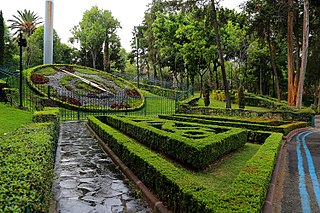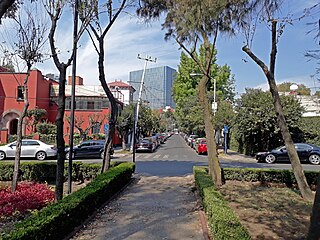
Naucalpan, officially Naucalpan de Juárez, is one of 125 municipalities located just northwest of Mexico City in the adjoining State of Mexico. The municipal seat is the city of Naucalpan de Juárez, which extends into the neighboring municipality of Huixquilucan.

Colonia Roma, also called La Roma or simply, Roma, is a district located in the Cuauhtémoc borough of Mexico City just west of the city's historic center. The area comprises two colonias: Roma Norte and Roma Sur, divided by Coahuila street.

Colonia Del Valle is a colonia in Benito Juarez borough of Mexico City. Founded as an aristocratic recreational neighborhood during the Porfiriato era, it has witnessed the various transformations of the capital over time. It includes a great number of parks, vast and tree-lined streets, prestigious shopping malls, and some city landmarks.

Ojuelos de Jalisco is a town and municipality in the state of Jalisco, Mexico. The town's 1990 population was 7,265, although by the year 2010 it had increased to 11,881.
Jardines del Pedregal or simply El Pedregal is an upscale residential colonia (neighborhood) in southern Mexico City hosting some of the richest families of Mexico. It is also known as the home to the biggest mansion in the city. Its borders are San Jerónimo Avenue and Ciudad Universitaria to the north, Insurgentes Avenue to the east and Periférico to the south and west. Its 510 hectares were a major real estate project undertaken by Mexican modernist architect Luis Barragán.
The Torre Bicentenario was a skyscraper project planned for construction in Mexico City. If built, at 300 meters (984 ft) tall, it would surpass the Torre Mayor as the holder of the title of Tallest Building in Mexico and same height as the highest building in Latin America. Torre Bicentenario was officially canceled, as announced by the local government and the involved investors on September 28, 2007. However, some facts indicate that the tower might be built, but not to be completed on the scheduled date.

Polanco is a neighborhood in the Miguel Hidalgo borough of Mexico City. Polanco is an affluent colonia, noted for its luxury shopping along Presidente Masaryk Avenue, the most expensive street in Mexico, as well as for the numerous prominent cultural institutions located within the neighborhood.
Alaquines is a municipality and town in the Mexican state of San Luis Potosí. It is 19 km away from Cárdenas.
Mario Pani Darqui was a Mexican architect and urbanist. He was one of the most active urbanists under the Mexican Miracle, and gave form to a good part of the urban appearance of Mexico City, with emblematic buildings, such as the main campus of the UNAM, the Unidad Habitacional Nonoalco-Tlatelolco, the Normal School of Teachers (Mexico), the National Conservatory of Music and other big housing projects called multifamiliares. His son Knut is a well-known artist.

Colonia Juárez is one of the better–known neighborhoods or colonias in the Cuauhtémoc borough of Mexico City. The neighborhood is shaped like a long triangle with the boundaries: Paseo de la Reforma on the north, Avenida Chapultepec on the south, and Eje 1 Poniente on the east.

Salón de la Plástica Mexicana is an institution dedicated to the promotion of Mexican contemporary art. It was established in 1949 to expand the Mexican art market. Its first location was in historic center of the city but today it mostly operates out of a building in Colonia Roma. The institution is run by a membership of almost four hundred recognized artists and holds multiple exhibitions each year. Although it operates autonomously, it is part of the Instituto Nacional de Bellas Artes y Literatura.

The Saint Augustine House is a landmark building located in the Historic center of Mexico City, on the corner of the streets Republic of Uruguay and 5 of February,.

The Museo de Arte Popular is a museum in Mexico City, Mexico, that promotes and preserves part of the Mexican handcrafts and folk art. Located in the historic center of Mexico City in an old fire house, the museum has a collection which includes textiles, pottery, glass, piñatas, alebrijes, furniture and much more. However, the museum is best known as the sponsor of the yearly Noche de Alebrijes parade in which the fantastical creatures are constructed on a monumental scale and then paraded from the main plaza or Zocalo to the Angel of Independence monument, competing for prizes.

The Battle of Monte de las Cruces was one of the pivotal battles of the early Mexican War of Independence, in October 1810.

The Palacio de la Autonomía is a museum and site where the Universidad Nacional Autónoma de México gained autonomy from direct government control in 1929. The building is from the late 19th century, and located on the corner of Licenciado de Verdad and Rep de Guatemala streets, north of Santa Teresa la Antigua and east of Templo Mayor. The site has a 500-year history, starting from part of lands granted by Hernán Cortés. The current building was constructed by the administration of President Porfirio Díaz, but it was ceded to the university in 1910. Since that time, the building has had a number of uses, including housing a dental school and a preparatory school. Today it houses the Museo de la Autonomía Universitaria.

Parque Hundido is an urban park located in Benito Juárez, Mexico City.
Colonia Santa María Insurgentes is a colonia in the Cuauhtémoc borough north east of the Mexico City’s historic center. The colonia’s borders are formed by the following roads: Calzada de San Simon to the south, Jacarandas to the north, Avenida de los Insurgentes Norte to the east and Jacarandas to the west.

The Colegio Franco Español is a private school in the San Lorenzo Huipulco colonia in Tlalpan, Mexico City. It covers preschool through high school (preparatoria) levels.

Mixcoac is an area of southern Mexico City which used to be a separate town and municipality within the Mexican Federal District until it was made part of Mexico City proper in 1928.

Guadalupe Inn is a colonia in Mexico City.

















